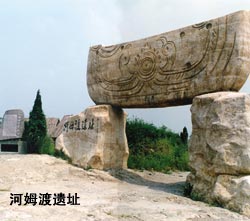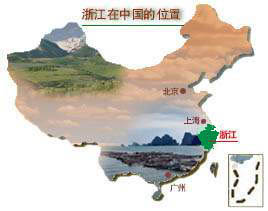Zhejiang
Zhejiang Province, located in the southern part of the Yangtze River Delta of the southeast coast of China, lies in the east of the East China Sea, south of Fujian Province, west of Jiangxi Province and Anhui Province, and north of Shanghai and Jiangsu provinces. Zhejiang, which literally means a zigzagging river, is named after the largest river in that territory, the Qiantang River. The name of the province is often abbreviated to its first character "浙" or Zhe, with Hangzhou as its provincial capital.
The straight-line distances between south and north and east and west are both about 450 kilometers, and the land area is 101,800 square kilometers, occupying 1.06% of the whole country -- one of China's smallest provinces. There are two sub-provincial cities in the province, namely, Hangzhou and Ningbo, and nine prefecture-level cities, namely Wenzhou, Huzhou, Jiaxing, Shaoxing, Jinhua, Quzhou, Zhoushan, Taizhou and Lishui. Governed by those cities or the province are 36 counties, 22 county-level cities and 32 municipal towns. The resident population of the province was 54.77 million at the end of 2012.


One of the major genres of Chinese operas, Yue Opera came into being in Shengxian County (now Shengzhou City) in the early 20th century. It is characterized bybeautiful melodies and lyrical plots. Popular plays include Liang Shanbo and Zhu Yingtai (known as the Chinese Romeo and Juliet), Dream of the Red Mansion, Aunt Xianglin, Romance of the Western Chamber, Five Daughters Offer Birthday Felicitations, Love Between Poet Lu You and His Cousin Tang Wan, and Mistake Made Through a Red Silk Braid. With a fine tradition of dramas, Zhejiang is also the birthplace of the ancient South Opera. In addition, there are many other kinds of local operas such as Wu Opera, Shaoxing Opera, Ou Opera, Yong Opera, Yao Opera and Hu Opera. In Zhejiang, different schools of painting and calligraphy with varied styles and features hold a significant position in the history of Chinese painting and calligraphy. In the 12th century, Zhejiang was the center of fine arts in the country. Since the 19th century schools of painting in Zhejiang have made splendid achievements and exercised a great influence over the development of Chinese painting and calligraphy. In history, distinguished painters and calligraphers from Zhejiang included Wang Xizhi (321-379 or 303-361), Yu Shinan (558-638), Chu Suiliang (596-658 or 659), Wu Zhen (1280-1354), Zhao Mengfu (1254-1322), Zhao Zhiqian (1829-1884), Ren Bonian (1840-1896) and Wu Changshuo (1844-1927). Some contemporary and modern famous painters and calligraphers are Huang Binhong (1865-1955), Pan Tianshou (1897-1971), Ma Yifu (1883-1967), Zhang Zongxiang (1882-1962), Lu Weizhao (1899-1980), Sha Menghai (1900-1993) and Zhu Lesan (1902-1984).
Rich in local artistic traditions, Zhejiang has cultivated varied and colorful folk culture and arts. Folk leisure activities are flourishing throughout the province, including the dragon dance, lion dance, hobby-horse dance, stilt walking, and various lantern shows. Folk songs can be heard in the fields, in the mountains, and on the rivers and lakes. Moreover, Zhejiang has various kinds of folk musical instruments. Famous all over the world are "Three Kinds of Carvings and One Kind of Sculpture", namely Dongyang wood carving, Qingtian stone carving, Wenzhou boxwood carving, and Ou sculpture. Dongyang wood carving was most prosperous in the last two feudal dynasties, i.e., the Ming (1368-1644) and the Qing (1644-1911). In terms of craftsmanship, Dongyang wood carving features high relief, multi-layers, well-conceived composition and an effect of solidity. The arrangement of patterns is elaborate yet controlled. Boxwood carving, so named because it is carved out of boxwood, is a sort of circular carving art in Yueqing, Wenzhou. Qingtian stone carving is the shaping of pyrophyllite with which this area is blessed. This kind of stone is colorful and artists design their works based on the specific stone's natural color, texture and shape so that the final products are a harmony of nature and art. Wenzhou Ou sculpture has a history of more than 1,000 years. It is also known as "oil sludge sculpture". Folk artists carve human figures or objects out of oil sludge plastered on plain boards or walls, looking both like oil paintings and relief. Besides, Zhejiang is also known for other folk arts such as paper-cutting, embroidery, dyeing, weaving and colored lanterns. The farmers' paintings from Xiuzhou in Jiaxing, Cixi in Ningbo and fishermen's paintings from Zhoushan are well known throughout the country. Folk dance, music, instrumental music, opera and various other forms of folk art including ballad singing, storytelling, comic dialogues, clapper talk and cross talk present unique features and styles and have drawn wide attention. The province is famous for its flourishing folk culture. As a result, a number of "Nationally Advanced Cultural Counties", "National Model Cultural Areas", “Homes of Folk Paintings in China" and "Homes of Folk Art in China" have emerged throughout the province.

 Province Events
Province Events Major Events
Major Events Highlights
Highlights
